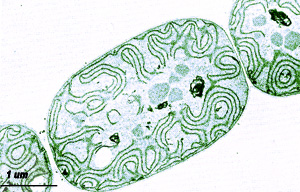Anabaena variabilis
A Microbial Biorealm page on the genus Anabaena variabilis

Classification
Higher order taxa
Bacteria; Cyanobacteria; Nostocales; Nostocaceae; Anabaena
Genus and Species
Anabaena variabilis
|
NCBI: Taxonomy |
Description and significance
Anabaena variabilis is a bacteria strain of blue-green algae that are known as cyanobacteria. Cyanobacteria are able to carry out photosynthesis, fix nitrogen from the environment, and also produce hydrogen. This feature of creating hydrogen with energy from the sun has made it popular in many laboratories in the world. The main role in its sequencing and research is because of the previous data collected regarding its physiology, biochemistry, and genetics can be better understood (4). This particular strain has also been described to have a “complex life cycle” that involved many types of cells that differentiate. The cells described were the “Heterocysts for nitrogen fixation, akinetes (spores) for survival, and hormogonia for motility and establishment of symbiotic associations with plants and fungi” (4).
The organism Anabaena variabilis was isolated at the U.S. Department of Energy Joint Genome Institute (DOE JGI). The DOE JGI listed that it sequenced the genomes of the organisms through the use of “whole-genome shotgun” (5). It described the technique as randomly “shearing” the genome DNA and then re-assembling it by comparing similar sequences and then inferring the original genome. The institute lists the three different size fragments that it can use and gives an example of how the procedure is done (5).
Genome structure
Describe the size and content of the genome. How many chromosomes? Circular or linear? Other interesting features? What is known about its sequence? Does it have any plasmids? Are they important to the organism's lifestyle?
Cell structure and metabolism
Describe any interesting features and/or cell structures; how it gains energy; what important molecules it produces.
Ecology
Describe any interactions with other organisms (included eukaryotes), contributions to the environment, effect on environment, etc.
Pathology
How does this organism cause disease? Human, animal, plant hosts? Virulence factors, as well as patient symptoms.
Application to Biotechnology
Does this organism produce any useful compounds or enzymes? What are they and how are they used?
Current Research
Enter summaries of the most recent research here--at least three required
References
Edited by Phuoc Nam Nguyen, student of Rachel Larsen and Kit Pogliano
